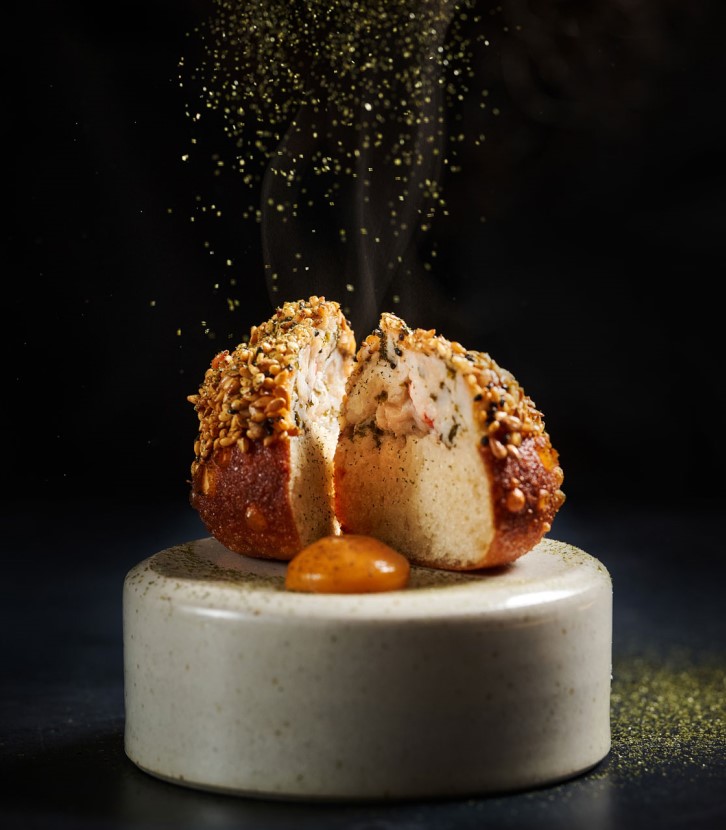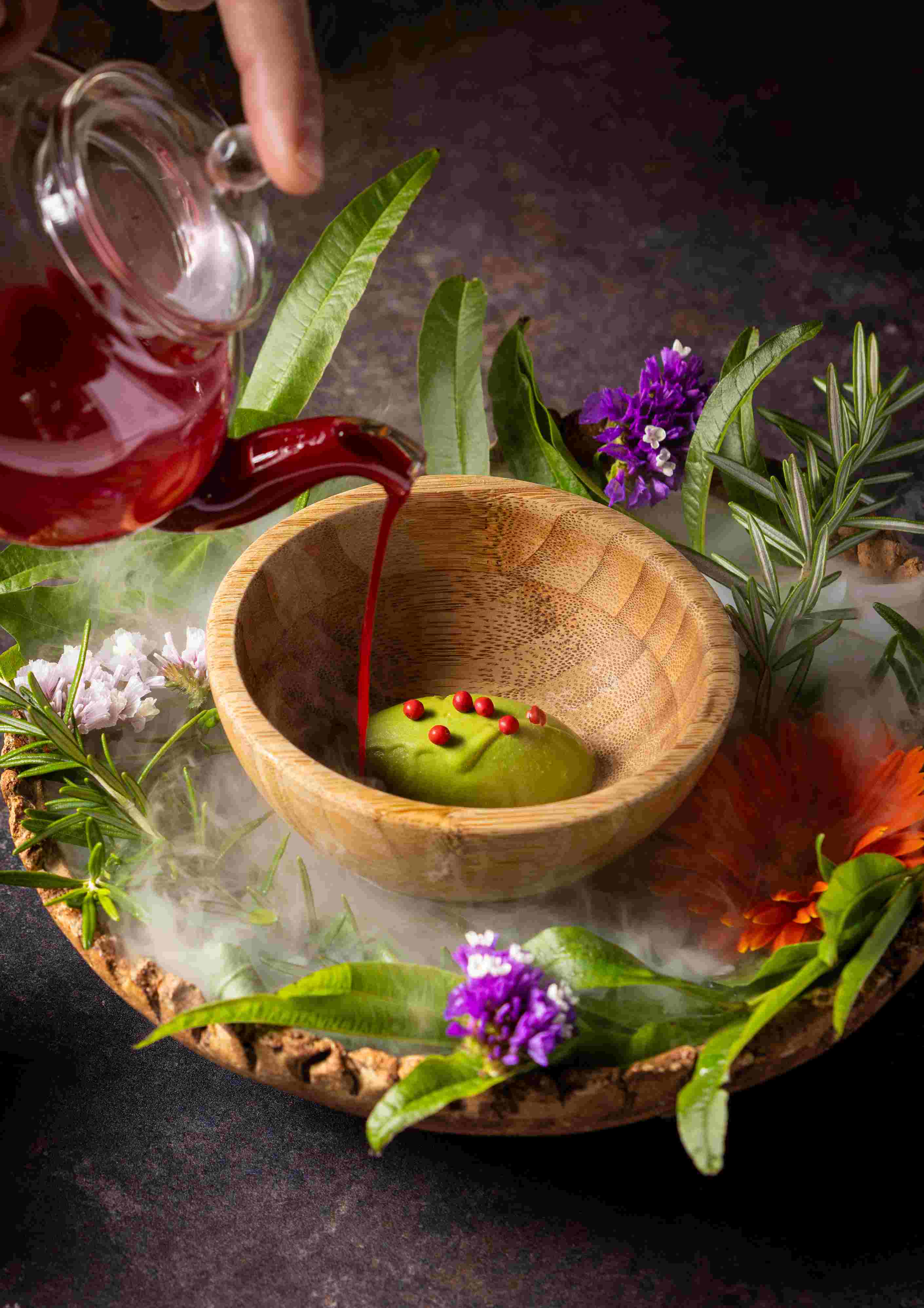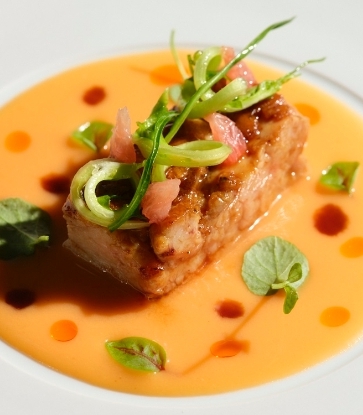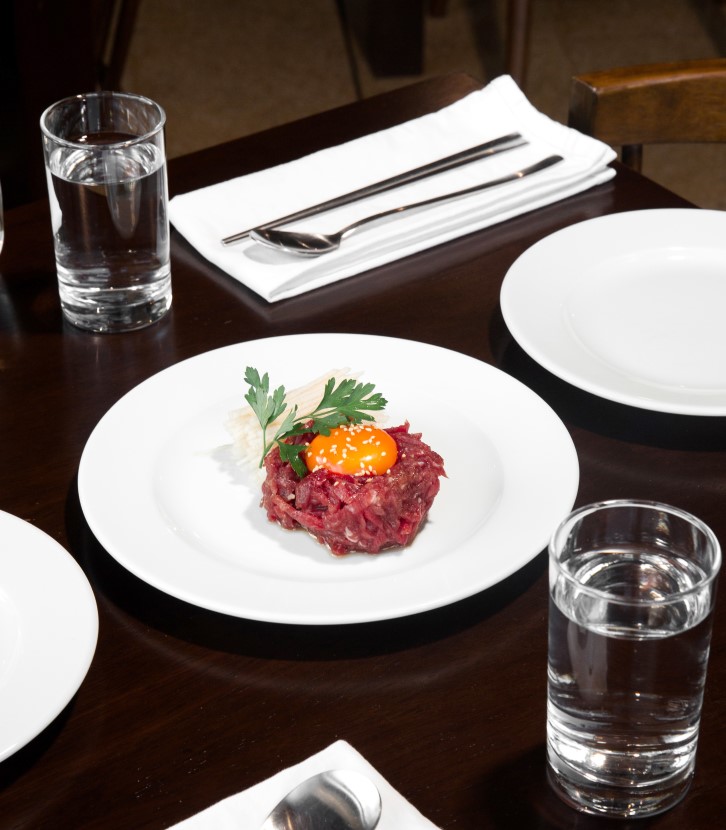It might have flown by for him, but Sat Bains has now been cooking in his idiosyncratic premises on Lenton Lane, just south of Nottingham, for a quarter of a century. Over the years, he has expanded his restaurant to include numerous other components including bedrooms and a kitchen garden – and of course there’s been the small matter of both attaining and continuously retaining Two MICHELIN Stars. So, as Restaurant Sat Bains turns 25, we spoke to the man himself about his restaurant and career. But first, a word from a MICHELIN Guide Inspector:
“There are not many chefs that are as driven, focused and forceful as Sat Bains. He has built his restaurant from pretty much ground zero over the past 25 years. The location always troubles some diners as it’s under a motorway fly-over, but the old adage is that 'people will always travel for good food' – and indeed they have done.
“For me, the core of Sat’s success comes down to two things: his savvy recruitment and his constant evolution. While Sat himself has never stood still, always looking to improve and move forwards, the team around him have allowed him to do this. From his wife Amanda to the parade of brilliant chefs who have gone on to achieve great things with Sat’s mentorship, they have all played their part in the restaurant’s consistently smooth running.”

Now, let’s hear from Sat Bains himself...
How does it feel to have reached 25 years – and to have held Two Stars for quite a lot of that time?
I think it’s quite surreal, number one, and it’s quite humbling to know that people still want to dine with us – and I feel really honoured. I feel really privileged that I've got a restaurant and a business that can stand the test of time. 25 years is no mean feat and it's gone so quickly it's almost hard to imagine. But then you're reminded, once you see how many of our team have gone on to become superstars in their own worlds, of how brilliant that is as a legacy – to see them shine and become brilliant advocates of our brilliant trade.
In those 25 years, how do you think the restaurant has evolved, both in terms of your cooking and the site itself?
The hardest thing in our game is relevance, especially when you’re an established restaurant. How do you stay relevant so that people are willing to spend their hard-earned money with you? I think what me and my wife, Amanda, have done is we’ve always reinvested. So we’ve always tweaked, looked at what we can improve. How do you give your guests a world class experience from the gardens right through to the rooms, from the chairs to the reception, from the music to the cutlery?
So we’re always keeping an eye on how we can improve things, and I think that's ultimately led to a really nice metamorphosis from 25 years ago. Back then it was more of a farmhouse, but now it's got a bit more of a design element, a bit more Japanese influence, a Scandinavian element. So it’s very minimal still. When you walk in as a guest what I want you to see is that there's definitely been an investment. Guests can feel that they’re going to be cossetted, looked after.
With the food, what's interesting is I've got a book from 2013 [Too Many Chiefs Only One Indian], which was then my book for all the years I've been in the kitchen. I still look at it now and there's dishes that are still relevant; the presentation might be a little bit different, but I've still got the same ethos. You know, I want to get the best ingredients I can get my hands on and I want to cook with care and attention. I want to make sure we don’t lose the identity of the ingredients, so if we're going to cook pigeon, it tastes like pigeon. We haven’t gone too far from the core ingredient. The same values are still there in terms of evolution.

Can you tell us a bit more about what you do to work towards being a more sustainable restaurant?
One of the big things was in 2015, we decided to close an extra day – we knew the impact that would have for our restaurant and our footprint – and we invested heavily into the garden. Our location’s crazy, near an industrial estate under a fly-over, with electricity pylons and everything else that goes with it. So we thought: ‘How do we make this little pocket of Nottingham super sustainable?’
So, we grow own herbs and some vegetables; we can’t grow them all, but by focusing on things that are really highly favoured, it means we don’t need a lot of space. We have two greenhouses and plots and that means we can grow really interesting things like pelargoniums that have that rose flavour, oyster leaf, things that are really intense in flavour. But we don't need a lot of space, so it's like an urban garden. Then we got solar power with a grant from the university; we got EV chargers with a grant from the Council; we collect all the rainwater for the garden.
We’re only a four-day operation – only open for two lunches – so we're trying to keep the amount of energy used really low. We compost all of our kitchen waste in a composter that's closed loop and that turns it into a dry matter over 24 hours, which then matures into compost over three months. We’ve got our own bees, two hives that can produce up to 60 kilos of honey a year, which is incredible.
Going back to 2012, we went all induction and got rid of gas in the kitchen. I went to a kitchen recently where the gas was on from breakfast until 11 at night, but was only used probably 20% of that time. It’s such a waste of energy and the fuel costs were horrendous. We make sure we keep on top of all the maintenance too. We make sure all the fridges are cleaned and we clean the fans so they don't build up grime and become inefficient and cool down the product.
We've been working really well with Nottingham University and Nottingham City Council. There’s a part of the university that’s all about sustainability and they helped us put a plan together by giving us a PhD student for a whole term to go through the business – where we could improve areas like automatic lights, going to LED. All these little things that make a big impact.

You’ve managed to have great longevity in this industry. What would you say is the secret to a long-lasting restaurant?
I think it's hunger. You've got to be hungry and there's a little bit of nervousness as well. We don't know how the industry’s going to pan out in the next 12 months. You've got to keep the energy high. You've got to keep the fire. That's something that's probably innate: the will to keep going, the will to keep pushing, the will to keep surviving and evolving and creating. So hopefully guests can see that.
When we see young chefs coming in to eat, we always show them around. Not to inspire, but just to show them what's possible. I've been in the kitchen for 37 years and I've been here for 25. I'm very fortunate to have had a very long career in something I love, so I try to get that passion across to the young team. I think if any chef is wanting a lifelong career in cooking, there's more to it than just cooking. It's about looking after yourself. It's about health, it's about welfare, it's about getting rest. Go to the gym, get some discipline, do something outside of work that's healthy.
When I was younger, we didn't have a lot of things like social media as a distraction. I was obsessed. I was reading The MICHELIN Guide, Larousse Gastronomique, Carême, Escoffier. I was obsessed with French cooking and I absorbed myself into it. Once I got the chance to be a Head Chef, all that passion came out. But I still wasn't sure what I was doing, because I was a young Head Chef; I hadn’t had that mentorship of working for a great Two- or Three-Star chef. I've had to learn a lot of it myself, but have been able to because of my inquisitiveness – which is why I always encourage my young team to keep writing stuff down. Any questions, ask them. I'm here all the time, ask me.
What do you want to know? What do you want to see? Because now you've got everything accessible on your phone. You can travel the world on your phone, just by Googling and viewing menus to see what chefs are up to. We never had that, you know, we had to write letters and wait for the menu to come by post, which could take two to four weeks coming from New York.

You released a book earlier this year, 'Eat to Your Heart’s Content', about heart-healthy food and your experiences as a heart attack survivor. How has your journey changed your relationship with food both in and out of the restaurant?
I think it's changed through the knowledge I’ve gained working with Dr. Neil Williams, who’s a nutritionist. It’s fascinating, the fuel that food gives to you. One thing we've all got to realise is our own body types. I'm male, over 50, Asian descent; I'm prone to heart attacks. That's my genetics. I found out through further tests that I hold on to cholesterol too, so I've got to be careful. I have a very high protein diet, I eat a lot of eggs, a lot of meat, but less carbs. But that suits my body type, so I can't preach that to everyone because you’ve got to do what’s right for you.
I think this industry is usually very hard, but you've ultimately got to make sure you can have a long life in it. And the way to do that is to mitigate stress with the opposite. You look after yourself, you get to bed at a decent time, you have consistency. Like you’re consistently striving to be the best in the kitchen, you've got to consistently strive to be the best version of you when you're not at work. We're lucky, we have three days off. So on a Sunday, all our guys might chill; Monday they might do all the chores; Tuesday they might go out for something to eat. That regime really creates structure and I think that's the key. When it's not structured, you're going to get stress or mental health problems or just stress from your body saying: ‘I can’t take this anymore.’
We introduced years ago a cashback plan for WPA health insurance. It gives you an allocation of say one or two thousand pounds a year towards dentists, chiropody etc. These are things that we've introduced to make sure our team are really clued up about looking after themselves, instead of wearing themselves into the ground. And also what's crucial is staff food, the family meal. Amanda is a stickler for it; she makes sure it's nutritional, makes sure there's a lot of diversity in there. If you're feeding them really, really nourishing food, they should be working really well and efficiently themselves.
My cooking at home is very much what the book is. That's where the recipes came from. It's very diverse; I grew up with Punjabi food and I love the idea of a table set with lots of little things and you have a nice empty plate, and you can pick and choose what you want. It means there's a nice range of salads, potatoes, vegetables, meat.

Just to go back to the 25 years, can you tell us about the collaboration dinners you've got planned to celebrate?
I've never done any collaboration dinners before. I don’t know why. Over the years, I've done a lot for other chefs and friends, but I've never thought of them coming to the restaurant. I don't know why, it's just something I never did. So I thought, ‘You know what, if we're going to do it, let's do something for the 25th.’ I've got an amazing alumni of chefs, restaurateurs, front of house, sommeliers, that have travelled through the restaurant and they're now working at some of the best restaurants in the world.
There’s Tom Spenceley and Harry Corder, Head Chef and Sous Chef at The Ledbury; Gareth Ward and Amelia Eiriksson at Ynyshir; and Laurent Richet who was our Master Sommelier for seven years and is in Rotterdam now as a consultant. So for the first dinner on the 10th October, I thought we’d invite back that old team and do a nine-course dinner, three courses from each restaurant, and Laurent can source the wines. Time goes very fast and one thing I've definitely learned through the heart attack is the biggest gift you can give anyone is your time. Forget presents; you spending time with someone is crucial because you're creating memories, and it's something that you're going to remember.
For the rest of the collaborations, I’ve asked loads of friends: Paul Ainsworth, Daniel Clifford, Jason Atherton, Claude Bosi, Michel Roux Jr, Rachel Humphrey, James Martin, Tom Kerridge, Angela Hartnett, Clare Smyth. I wanted a snapshot of what’s going on in Britain from the generation of chefs that I grew up with, because I've looked up to them, they’ve become friends and it'd be nice for our guests in Nottingham to have a little taste of another chef’s food to go with ours. There’s quite a few I'm looking forward to, but one I'm really excited about is Nathan Outlaw's, because we're going to do an old Marco Pierre White book title called Wild Food from Land and Sea. He'll do all the fish and I'll do all the game.

You mentioned before that you’re in an unusual location for a Two-Star restaurant. Have you ever considered leaving the site on Lenton Lane?
It’s really strange, but it's almost what made me. When I was younger, my dream was to have a restaurant in a very obscure location, because in my head I had this vision that ‘they’ll only come because of the food’. It didn’t matter where it was – it could be a shed. I’ve probably unknowingly created that. If you take a lovely country house hotel, I’ve been let down by some restaurants like that as the expectations are so great. Whereas we’ve got to try hard because, number one, as soon as you drive into our lane off the motorway, you're already like, ‘What the hell's going on here?’
It means, as a restaurant, we've got to try harder – but I like that. I like the fact that we've got to put so much effort in because it stops you being stagnant, lazy, complacent – which are all the death marks of a restaurant. You've got to stay relevant. You've got to keep pushing. You've got to make sure that the vegetables look pristine and the chefs are pristine during service and the front of house are ready for their guests walking in. That excites me today even more than it did back then, because now they're coming to eat our food and they're paying very good money, hard-earned money, to eat in our restaurant – and I'll never take that for granted. I think that for me is why moving from here would lose some of the DNA of what’s created my cuisine and my philosophy as a chef and as a restaurateur. I think the barriers we've had to jump over have given us a real solid identity and they’ve given us something that's really unique, not just in The MICHELIN Guide, but in general as a restaurant with rooms.
Another thing which is very interesting is we get a lot of chefs coming to eat here and that’s because they want to see it. Now we've got this legacy of all these chefs that have been through the doors over the years, we don't really struggle to recruit. Young chefs are really willing to put their career in our hands for probably three to four years, but then the whole world is your oyster after that. One of my old chefs wanted to go to Benu in San Francisco, and that's just an email and a text. We know a lot of chefs because we've been in the same industry for some time. So it's a very nice, rewarding mechanism for the team. One might want to do a 'stage' in California, one might want to go to Japan; we know enough chefs now that we can hopefully house them, plus give them inspiration and aspirations to be better.
You know, even though I've been a chef for 37 years, I still don't know anything. I'm still trying to learn my craft. I'm still pushing myself, then pushing my team to be better. I think that's the energy our customers feel when they're here. They know it's unique. They know it's different, but they also see this passion and desire and the will to be better – and I think that's the key to a long life in this industry.
Please note: Some of Sat’s answers have been edited for clarity and length.
Hero Image: © Restaurant Sat Bains/Jodi Hinds





















